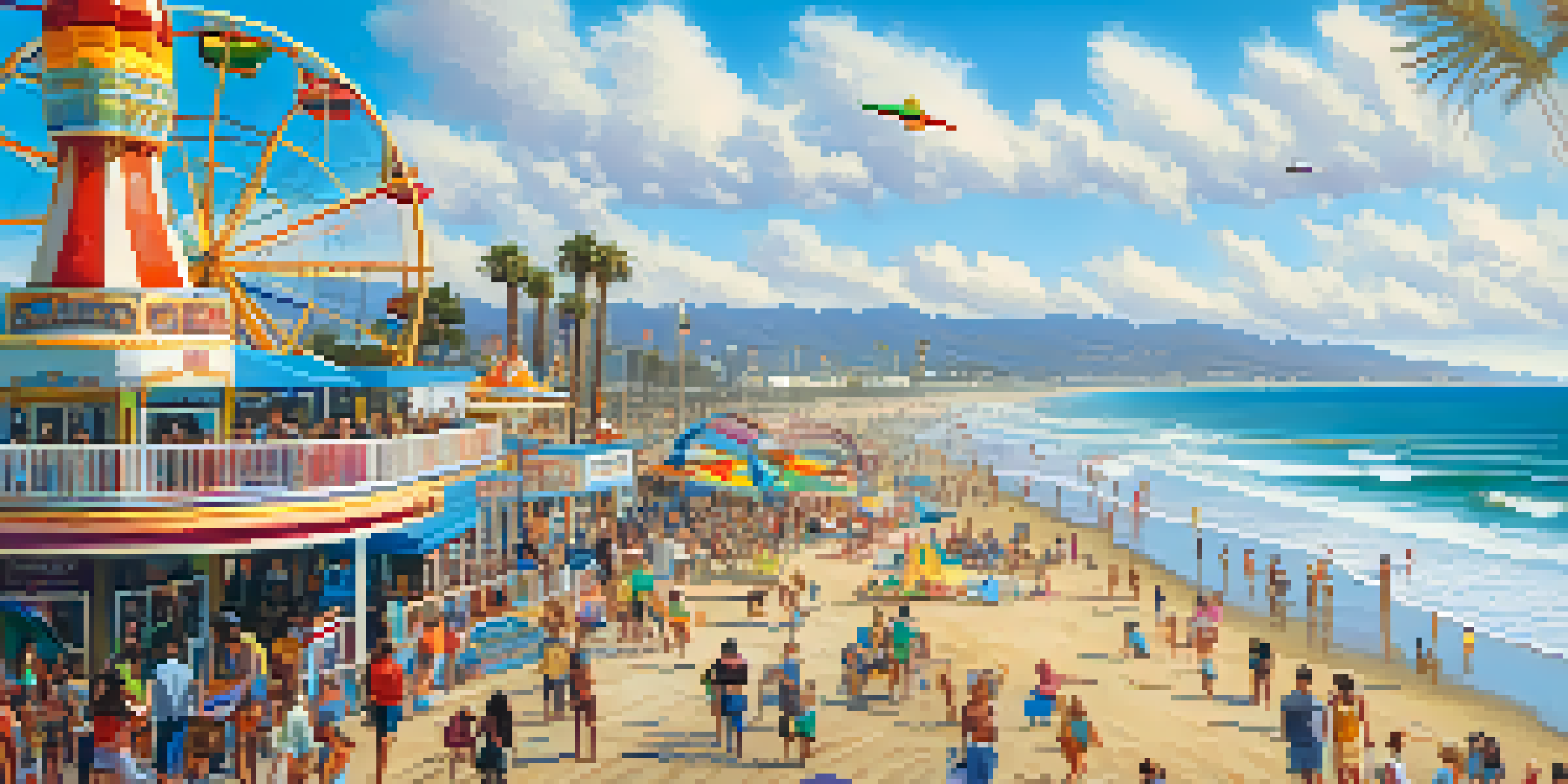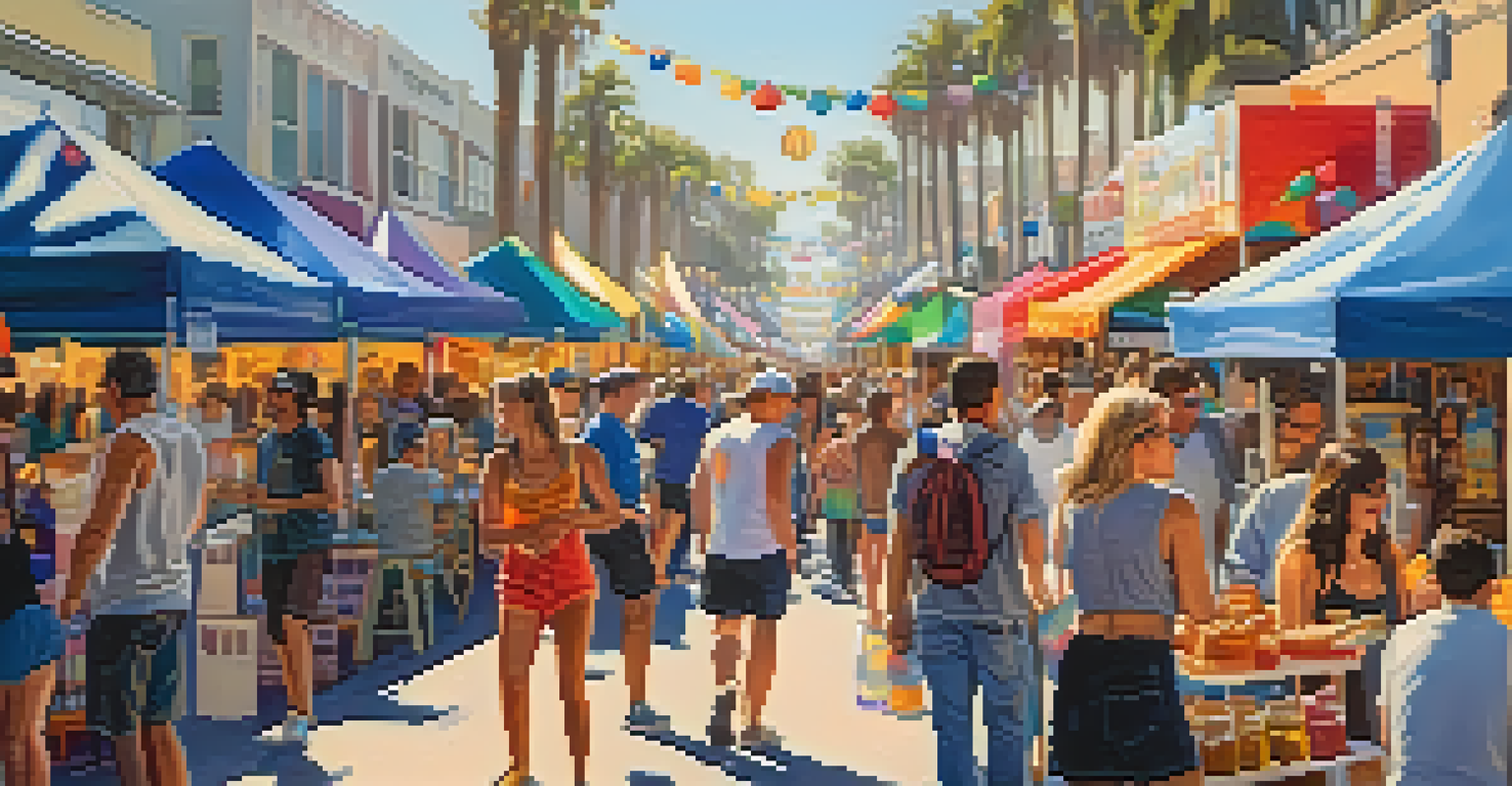The Evolution of Santa Monica's Economy: A Historical Review

Early Beginnings: Santa Monica's Economic Foundations
In the late 19th century, Santa Monica began as a small coastal settlement, primarily focused on agriculture and fishing. The fertile land and proximity to the ocean provided residents with ample resources for sustenance and trade. As the area grew, it quickly attracted visitors, laying the groundwork for a burgeoning tourism industry.
The economy is not a static thing; it's a dynamic entity that requires constant attention and adaptation.
The arrival of the Pacific Electric Railway in 1909 marked a significant turning point, connecting Santa Monica with greater Los Angeles. This connection not only facilitated transportation but also spurred real estate development, leading to an influx of new residents and businesses. Soon, Santa Monica transitioned from a quiet town to a vibrant community.
By the early 20th century, the local economy began diversifying, with hotels, restaurants, and amusement parks popping up to cater to the increasing number of tourists. This shift set the stage for Santa Monica's reputation as a premier seaside destination, fostering both economic growth and cultural evolution.
The Impact of World War II on Local Economy
World War II brought about significant changes to Santa Monica's economy, as the city became a hub for military production and training. The establishment of the Douglas Aircraft Company in 1939 transformed the local job market, providing thousands of jobs and attracting workers from all over. This boom not only boosted the economy but also changed the demographic landscape of the city.

As a result of increased employment opportunities, local businesses flourished, providing goods and services to a growing population. The demand for housing surged, leading to the construction of more residential areas, which further fueled economic growth. The war years marked a period of prosperity for Santa Monica, embedding a strong work ethic and community spirit among its residents.
Tourism Drives Santa Monica's Growth
The post-World War II tourism boom established Santa Monica as a premier seaside destination, significantly boosting its economy.
However, the post-war era brought challenges, including the need to transition from a wartime economy back to peacetime. Santa Monica had to adapt to changing economic conditions, which ultimately paved the way for new industries to emerge, ensuring the city remained resilient and forward-looking.
The Rise of Tourism and Hospitality
Following World War II, Santa Monica experienced a tourism boom that transformed its economy. The city's stunning beaches, iconic pier, and year-round sunny weather attracted visitors from across the globe. This influx of tourists led to the development of hotels, restaurants, and entertainment venues, creating a thriving hospitality sector.
Sustainability is not just about the environment; it's about our economy and our future.
As tourism became a cornerstone of Santa Monica's economy, local businesses adapted to cater to diverse visitor needs. From boutique shops to trendy cafes, the city embraced its identity as a tourist destination, fostering a vibrant local culture. Events and festivals celebrating local art, music, and cuisine further enhanced its appeal.
However, reliance on tourism also brought challenges, particularly during economic downturns or global crises. Santa Monica's economy had to become more resilient, diversifying its offerings while still capitalizing on its unique coastal charm to attract visitors year-round.
Technology and Innovation: A New Economic Era
In the late 20th and early 21st centuries, Santa Monica embraced the technology boom, positioning itself as a hub for innovation. The city's proximity to Silicon Beach attracted startups and established tech companies, creating a dynamic job market that appealed to a younger, tech-savvy workforce. This shift not only revitalized the local economy but also brought a fresh energy to the community.
As tech firms flourished, they contributed to a ripple effect in other sectors, including real estate, dining, and retail. The demand for modern office spaces led to new developments, while an influx of young professionals reinvigorated local businesses. Santa Monica's economy began to shift towards a more knowledge-based model, emphasizing creativity and collaboration.
Tech Boom Reshapes Local Economy
The rise of the technology sector in the late 20th century transformed Santa Monica into a hub for innovation, leading to a dynamic job market.
However, the tech boom also raised concerns about housing affordability and the potential loss of Santa Monica's unique character. Balancing economic growth with community needs became essential, prompting local leaders to explore sustainable development strategies that would ensure a thriving economy without compromising the city's charm.
Challenges: Economic Disparities and Housing Issues
Despite its economic successes, Santa Monica faces significant challenges, particularly in terms of housing affordability and economic disparities. As the tech industry flourished, the cost of living surged, making it increasingly difficult for working-class residents to find affordable housing. This issue has ignited debates about gentrification and the preservation of the city's diverse character.
Local leaders have responded by implementing policies aimed at increasing affordable housing options and preserving existing neighborhoods. Initiatives like inclusionary zoning and community land trusts aim to balance development with the needs of long-term residents. However, these efforts require ongoing dialogue and collaboration among community members, developers, and policymakers.
Addressing economic disparities is crucial for Santa Monica's future, as it seeks to create an inclusive economy that benefits all residents. By focusing on equitable growth and community engagement, the city can work towards a more sustainable and harmonious economic landscape.
Santa Monica's Green Economy: Sustainability Efforts
In recent years, Santa Monica has made significant strides towards building a green economy, focusing on sustainability and environmental responsibility. The city has implemented initiatives aimed at reducing waste, conserving energy, and promoting renewable resources. By positioning itself as a leader in sustainability, Santa Monica not only enhances its appeal but also attracts eco-conscious businesses and residents.
Local policies encourage sustainable practices, such as green building standards and incentives for electric vehicle usage. These efforts have not only reduced the city’s carbon footprint but have also fostered economic growth in the green technology sector, creating new jobs and opportunities for local entrepreneurs. Santa Monica's commitment to sustainability is a testament to its forward-thinking approach.
Housing Affordability Challenges Persist
Despite economic successes, Santa Monica faces ongoing issues with housing affordability and economic disparities, prompting local leaders to seek sustainable solutions.
Furthermore, community involvement is key to these initiatives, with residents actively participating in local programs and events. This engagement fosters a sense of ownership and pride, enabling Santa Monica to thrive as a model for other cities aiming to balance economic growth with environmental stewardship.
The Future of Santa Monica's Economy: A Vision Ahead
Looking ahead, Santa Monica's economy is poised for continued evolution, shaped by its history and the challenges it faces. Embracing a multifaceted approach that prioritizes innovation, sustainability, and community engagement will be essential for fostering a resilient economy. The city’s ongoing commitment to inclusivity and diversity will play a crucial role in shaping its future.
As new industries emerge and existing sectors adapt, Santa Monica can capitalize on its strengths while addressing long-standing challenges. By fostering collaboration between businesses, residents, and local government, the city can create a more balanced economic landscape that benefits everyone. This vision underscores the importance of proactive planning and community involvement.

Ultimately, Santa Monica's future economy will reflect its unique identity and values, blending its rich history with a forward-looking approach. With an eye on sustainable growth and equitable opportunities, Santa Monica can continue to thrive as a vibrant coastal community that attracts residents and visitors alike.